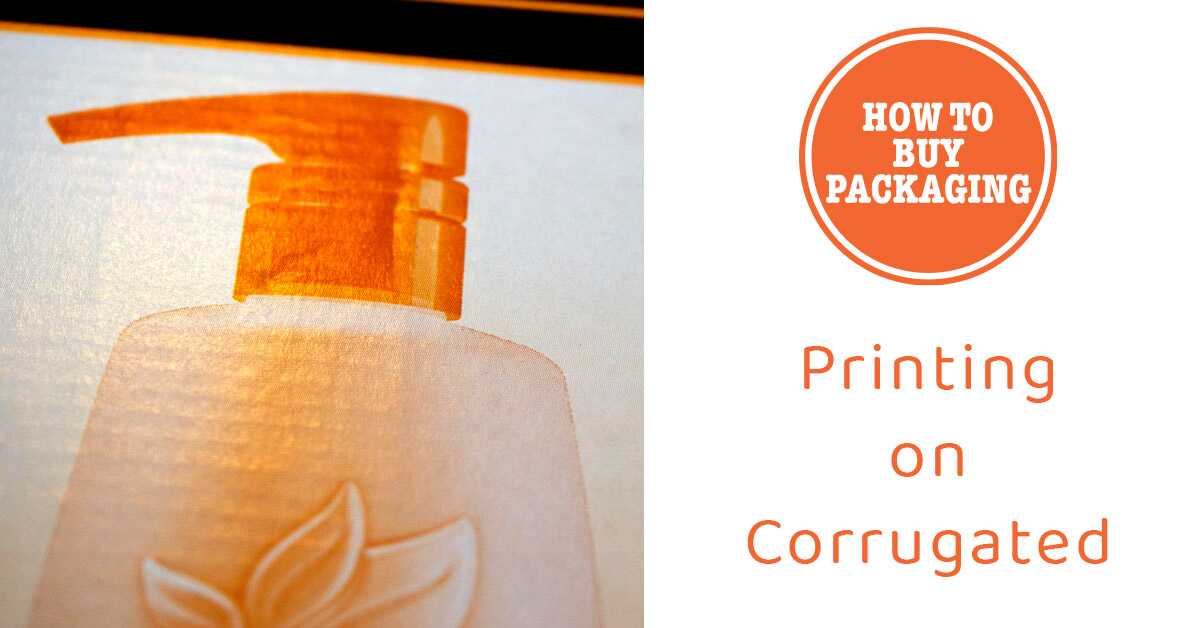There are several options when it comes to printing on corrugated boxes, and each option has its pros and cons. The decision as to which type of printing process to use is influenced by budget, time constraints, and print quality desired. Whether the boxes are going to be used for shipping or for primary retail packaging is also a factor that influences the type of printing required.
First, I’ll discuss the different ways for printing on corrugated boxes followed by the different print processes that are typically used for corrugated.
If you don’t understand some of the following terminology, don’t worry, just check out this article on corrugated boxes first and it will quickly get you up to speed. 🙂
There are two basic ways of printing on corrugated boxes: Direct Printing and Pre-Printing.
Direct Printing
Printing direct (also called “post print”) means printing directly onto the corrugated box. It is the most common way to print on corrugated. It is usually done with flexography or digital printing (both explained later on in this article).
Pre-Printing:
Achieving amazing quality printing is tricky when printing directly on corrugated board (unlike when directly printing on, for instance, paperboard used for folding cartons, which can yield gorgeous results). Because of this, printing on a sheet of paper first and then gluing it to the corrugated box is the answer to stunning looking graphics.
There are several ways to accomplish this:
1. Printing on the Linerboard
Printing on linerboard first, before it is glued to the medium, can yield better print quality than printing on the linerboard once it is attached to the medium (which would then be “direct printing”). This linerboard can be kraft (light brown color), solid bleached, white, or coated. The print quality is considered to be better than direct printing but not quite as good as litho label (discussed below). However, the volume must be high for this method of printing to make sense. Because the linerboard is on a huge roll (called roll stock) and generally weighing one ton, the packaging buyer must usually purchase this entire roll. Even though this requires a high volume, it results in a very low unit cost.
2. Laminating Paperboard onto Single-Face Corrugated:
Typically using 8pt to 12pt paperboard (used to make folding cartons) and laminating it to single-faced combined board (exposed flutes) not only offers the options to use litho and rotogravure printing, but also offers a more durable outer linerboard than the standard corrugated box linerboard which provides more strength than any paperboard folding carton could offer.
3. Litho-Labeling:
And now for the processes that are most common for printing on corrugated boxes.
- Flexography
- Offset Lithography
- Digital Printing
Flexography (Flexo)
Simply put, flexo printing is like a “very sophisticated rubber stamp”. This type of printing process prints easily on rough materials like corrugated and smooth materials like coated liners. Good printing speeds and fairly quick set-up time make this a popular and dominate choice for printing on corrugated. Flexo is great for printing on shipper boxes and primary retail packaging. It is often best used to print non-photo quality images using PMS colors instead of 4 color process, as the PMS colors tend to be deeper and more vibrant. The following box uses flexo direct printing onto coated corrugated board.
When using corrugated for primary retail packaging, it is often desirable to use litho label for eye-catching colors and amazing graphics quality (I’ll talk about litho label next). However this doesn’t alway have to be the case as flexo can print photo quality images and do a pretty good job at it (in the right hands). The next image below shows excellent flexographic print directly onto coated (white) corrugated board. The print quality is not nearly as sharp and vibrant as a litho label would have been, but the quality here is still very good for less money than a litho label.
Flexo is usually the less expensive printing method, but the cost of plates can be high, and if you change any of the artwork, new plates need to be made.
Offset Lithography (Litho)
This print quality is excellent and quite cost effective for high volumes. However, lithographic printing is predominately used for printing on labels (called litho labels) which are then glued to the corrugated box, as opposed to any kind of direct litho printing on corrugated boxes. Litho is used if you want stunning photo realistic images as well as foil stamping, embossing, spot gloss or any other exterior embellishments.
Here is an example of a beautiful litho label with a foil stamp on a corrugated retail box.
A litho label often times covers the entire box, but it doesn’t necessarily have to. Below is an example of a “spot litho label”. This is where the litho label only covers a portion of the box, while the top of the box, in this case, is direct printed using flexo. This approach still looks great and can save money.
Lithography generally comes with a higher price tag (unless ordering massive volumes) and tooling, such as printing plates, can be expensive (just like with flexo) which, of course, need to be remade if artwork changes.
Digital Printing
Digital presses are not unlike digital printers used in homes. And since they use digital files, there is no need for expensive printing plates. There is also virtually no setup required. Digital printing offers higher quality graphics than flexo, and low volumes are ideal, speedy and cost effective. Digital printing is no joke – look at how gorgeous this digitally printed POP display is. This is a direct digital print on E-flute corrugated board.
At the moment, digital printing is mostly practical for short runs: test marketing, production shortages, trade show samples etc. But, as we all have seen, technology continues to get better and cheaper. It is inevitable that digital printing will one day be the dominate printing method making flexo, litho and all the rest obsolete. Printing speeds will continually increase, quality will become preeminent, and costs will get lower and lower for both high and low volumes.
What is the Best Method to Use When Printing on Corrugated Boxes
That depends on your needs. Ask yourself a few questions first:
Will I need primary retail packaging, POP (point of purchase) displays or shipper boxes?
- If you want shipper boxes, then flexo printing for sure. Depending on the type of product, litho label may be the way to go as it will yield much better results if you need printing on primary retail packaging or stunning POP displays.
How many colors will I need?
- If you only need a few PMS colors, flexo is probably your best bet.
Will I need photo quality printing?
- If so, go with a litho label if you have the volume, digital if you don’t.
Are the boxes going to be refrigerated, packaging food or other regulated products?
- This is definitely one to go over with the manufacturer.
What is my volume?
- Lithography (including litho labels) generally requires the highest volumes to be cost effective. Flexo is generally cheaper so having low volumes is not necessarily a deal breaker. But, digital is the way to go for low volumes.
How quickly will I need it done?
- If you need it done yesterday, and your volumes are not too high, digital – without question.
It is important to have these questions ready when you speak with a manufacturer or sales rep. They will be best at advising you as to what type of printing you’ll require for your specific needs. Bear in mind, not every manufacturer will have all the above printing options readily available in their factory, they may have to outsource which could cost you more.
And after reading this article it is my hope that you will at least have better knowledge of what the manufacturer is talking about with regards to your corrugated box printing options.
This has been a part of my tutorial series called How to Buy Packaging 101. So click the link below to head back if you haven’t finished reading it yet. 🙂


2 Responses
Exiting article indeed. I enjoyed reading this and yes I agree, offset lithography is quite cost effective.
Sara:
You did an excellent job describing the differences between direct printing and Litho and the implications this has from a cost and quality perspective.
We started the direct printing process, and your article makes a lot of sense. Maybe you can write something about corrugated “E”, “F”, “N” for the next article.
Thanks for sharing.